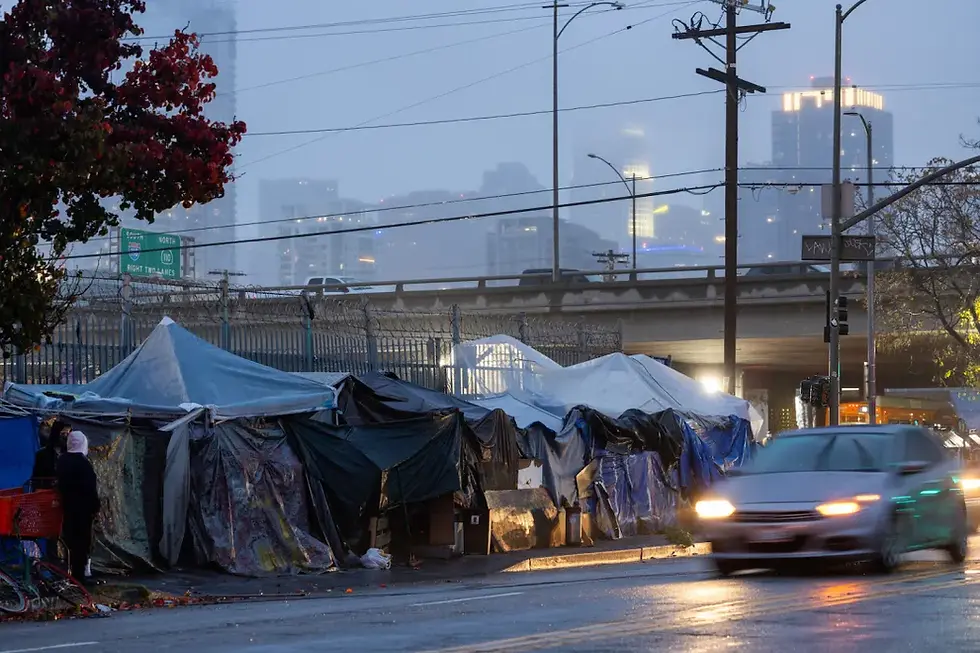How Cold Weather Became the Silent Killer of L.A.'s Homeless
- Julius Miller

- Jan 23, 2024
- 4 min read
One month ago, Los Angeles Fire Department spokesperson Brian Humphrey reported receiving a call for a dispatch to Sepulveda and Century Boulevards. The caller, unidentified, was instructed to perform CPR on a one-year-old child she had found at a bus stop.
Yayra Rutherford was pronounced dead on the scene and though her cause of death has been deferred, her mother, Amantha Van Cleave, previously alluded to cold exposure.
“It's very possible that she did freeze to death. It's possible because she was fine the night before,” Van Cleave previously told FOX11.
Van Cleave, 26, was new to the city and actively fleeing from an abusive relationship. She attempted to make ends meet by picking up rides for Uber, but ultimately became part of Los Angeles’ unsheltered homeless population, caring for Yayra and her two-year-old son, Judah, under an overpass near LAX.
Though Van Cleave says she had previously been a pharmacy tech with a degree and had “never been on drugs,” her lack of stable housing made employers look elsewhere. “When my car died, that’s when everything went downhill. We ended up outside, sleeping at LAX for a good two weeks, during all that raining, we were outside,” she said to the outlet.
“I have a call log to this day of calling around and nobody had answers for me or anywhere for us to go,” she added.

Van Cleave’s story is just one of many across California and Los Angeles of unsheltered homeless individuals who struggle to find housing year-round. During the fall and winter seasons, this elongated exchange can turn fatal. In 2021, county data revealed that at least 14 unhoused people had frozen to death, The Guardian reported. Just two years earlier, five people met the same fate.
Perhaps the most shocking factor of it all, however, is just how preventable it is. Comparatively, L.A. homeless deaths by cold exposure that year, 2019, surpassed both San Francisco and New York, which recorded two deaths each.
“The trauma of being homeless, the physical and emotional trauma of being homeless exists for anybody in unsheltered homelessness,” Stephanie Klasky-Gamer, President and CEO of LA Family Housing tells Los Angeles magazine. “We really do work very hard in getting every family and child inside. But there aren’t enough resources, and there certainly is not enough shelter.”
Klasky-Gamer has been at the forefront of aiding the city’s homeless population since 2007 when her team was comprised of just 65 employees and a $6 million annual operating budget. She suggests that the city’s struggles to tackle homelessness may lie in L.A.’s incredible lack of infrastructure dedicated to sheltering the homeless, or, more so, its inability to sustain.

“I think what the general public might not understand is how few shelter beds we actually have,” She says. “Many people believe that [the homeless] are outside or not outside because they choose that, [but] they're outside because we don't have places for them to go."
By comparison, New York City reported in 2023 that only 3,600 people were experiencing “street homelessness.” And though that number may soon rise due to the functional end of its 42-year-long “right to shelter” mandate in December, in L.A., that figure still lies substantially higher at roughly 33,000 in the city alone.
“They might live in a shelter for three, four years because they don't have enough permanently affordable rental or supportive housing in New York, but at least they're inside,” Klasky-Gamer adds.
Issues may date back to a string of ineffective policies in the ‘80s and ‘90s. For example, one General Relief Program titled Section 17000 promised that “(e)very county and city shall relieve and support all incompetent, poor, indigent persons, and those incapacitated by age, disease, or accident, lawfully resident therein.” However, county rules required those attempting to access the program to have identification and proof of residence, which many homeless people did and still do not have. As a result of various factors and walkthroughs in legislation, four people froze to death in 1987 alone.
By the 21st Century, actions to address the homeless epidemic took a turn for the better. According to a report from UCLA’s Luskin for History and Policy, “despite the challenges of implementing such policies as the Homeless Prevention Initiative and Project 50 in the 2000s, Los Angeles has undergone a significant change in its experience of, and response to homelessness.”
2016, LAHSA’s homeless count revealed that the population of unhoused individuals had grown by a shocking 19 percent in one year. In addition to this, L.A. Taco reported that during that same year, three unhoused people died during a four-day period in January due to hypothermia and other underlying conditions
City Council and voters soon took action, passing Proposition HHH in 2016, which would enable officials to issue $1.2 billion in bonds towards the construction of “permanent supportive housing.” Just a year later, Measure H would go into effect, implementing a quarter-cent sales tax that would go towards “addressing and preventing homelessness.”

“We own and operate about 30 properties of both firmly affordable, permanent supportive and interim housing,” Klasy-Gamer says of LAFH’s growth since she came in. “We have another about 10 deals in our pipeline, with approximately 800 Plus units opening up in the next few years, all permanent supportive housing.”
Despite a 62 percent increase in shelter beds since 2019, the city struggles to keep up with the rising homeless population, with the city of L.A. witnessing a 32 percent increase between 2018 and 2020. A 2022 count showed that the increase had slowed down, but still rose 1.7 percent. Given that a count was not conducted in 2021 due to COVID, that statistic may be skewed.
Meanwhile, L.A. County Coroner Data emphasized the unsheltered issue, with an average of at least seven deaths among the homeless between 2016 and 2021 with cold exposure and hypothermia cited as contributing factors, ABC7 previously reported.
But Angelenos can help out, though not by themselves. Offering blankets and sleeping bags to the homeless can often do more harm than good in the long term. For a population that is constantly on the move, heavier objects quickly become a hindrance.
“Find your local service provider and volunteer with them,” Klasky-Gamer suggests. “Because they're going to know what the unique and specific needs are of the population that they're serving.”
In addition to this, you can volunteer for the city’s homeless count, because “knowing exactly how many people are out there” is “part of the solution in ending homelessness.” The count starts on January 23, 2024 and runs until the 25.






Commentaires